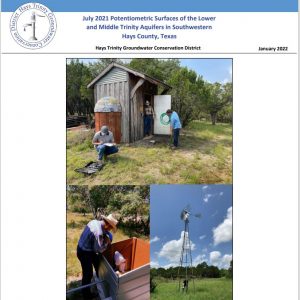July 2021 Potentiometric Surfaces of the Lower and Middle Trinity Aquifers in Southwestern Hays County, Texas

In the western portion of Hays County and northeastern Comal County, residents depend on the Lower and Middle Trinity Aquifers as their water sources. Water from these two aquifers is used for domestic and agricultural purposes for a rapidly expanding population. According to the United States Census Bureau, Hays County ranked second for all counties in the nation in percent growth from 2010 to 2019 (USCB 2020). The development of data into science is critical for the coordinated management of water resources in both aquifers.
The Lower Trinity and Middle Trinity Aquifer potentiometric surface maps presented in this report are indices for aquifer health and characterize Trinity Aquifer flow regimes in-depth. The maps provided are compared to previous studies, such as Davidson (2008), Watson et al. (2014), and Hunt et al. (2019), and will be valuable timestamps for future studies. Additionally, basic water chemistry data were collected for both aquifers during this study and are discussed in this report.
The study area centers on the Hays Trinity Groundwater Conservation District’s (HTGCD) Regional Recharge Study Zone (RRSZ), located near the western-southwestern boundary of Hays County within the Blanco River and Cypress Creek watersheds (Gary et al. 2019). HTGCD Rule 16 defined the RRSZ in rule and was made effective on January 1, 2020, and outlines the need for more data to further our understanding of the hydrogeologic system (HTGCD, 2020). Some objectives in the RRSZ include increased monitoring of the Middle and Lower Trinity Aquifers and furthering our knowledge of the water availability of these aquifers. Additional data were collected in the Jacob’s Well Groundwater Management Zone (JWGMZ) and the adjacent northern section of Comal County’s Comal Trinity Groundwater Conservation District (CTGCD). Well visits were performed from July 12 to August 5, 2021.